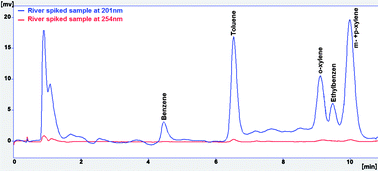Development and optimisation of quantitative analytical method to determine BTEX in environmental water samples using HPLC-DAD
Abstract
Petroleum contamination of groundwater and waterways is common throughout the world. Among the

* Corresponding authors
a
Department of Chemistry, Faculty of Sciences, University of Damascus, Damascus, Syria
E-mail:
yamensalka@yahoo.com
Fax: +963 11 44 68 41 41
Tel: +963 933 30 64 59
Petroleum contamination of groundwater and waterways is common throughout the world. Among the

 Please wait while we load your content...
Something went wrong. Try again?
Please wait while we load your content...
Something went wrong. Try again?
Y. AlSalka, F. Karabet and S. Hashem, Anal. Methods, 2010, 2, 1026 DOI: 10.1039/C0AY00285B
To request permission to reproduce material from this article, please go to the Copyright Clearance Center request page.
If you are an author contributing to an RSC publication, you do not need to request permission provided correct acknowledgement is given.
If you are the author of this article, you do not need to request permission to reproduce figures and diagrams provided correct acknowledgement is given. If you want to reproduce the whole article in a third-party publication (excluding your thesis/dissertation for which permission is not required) please go to the Copyright Clearance Center request page.
Read more about how to correctly acknowledge RSC content.
 Fetching data from CrossRef.
Fetching data from CrossRef.
This may take some time to load.
Loading related content
